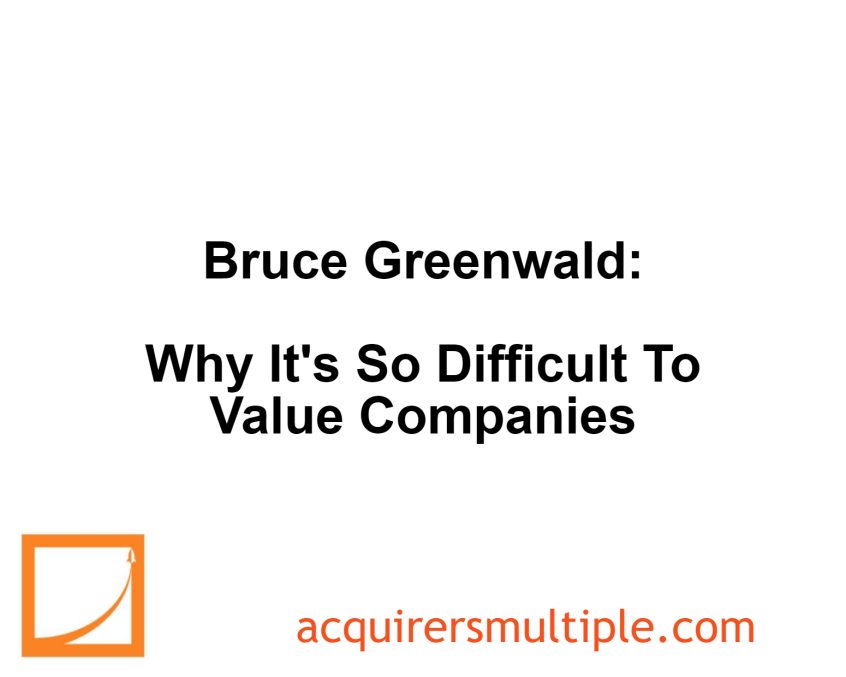In this interview with MOI Global, Bruce Greenwald discusses why it’s so difficulty to value companies. Here’s an excerpt from the interview:
Greenwald: Let’s talk a little about how you value growth because that’ll give you a feel for how hard it is and how important it will be to know that business and be specialized. If you think of a growing firm and buying a growing firm, most of the value is way out there in the future.
Typically, when you do a DCF on a growth stock, you’ll do five years of cash flow projections, and then you’ll do a terminal value. Somewhere above 80% of all the value will be in the terminal value.
The terminal value will be a terminal cash flow times a multiple, and the multiple is one over the difference between the growth rate in that terminal cash flow and the cost of capital.
If the growth rate is four and the cost of capital is eight, 4% is the difference. The multiple will be one over four percent or 25%. But suppose you’re off by 1% in either of those numbers.
Suppose the growth rate is not 4%, it’s 3% instead. The cost of capital is not 8%, it’s 9% minus 3%, 6%. One over six percent is 16x, not 25x. On the flip side of that, suppose the growth rate is 5% and the cost of capital is 7% and these are 1% errors in projecting a long-term future. Seven minus five is 2%.
One over two percent is a 50x multiple. Within a narrow range of forecasted growth rates and what future risks might look like, you can get a 3:1 variation in multiples. You had better be an expert if you play that game.
You can read the entire interview here:
Bruce Greenwald Interview – MOI Global
For all the latest news and podcasts, join our free newsletter here.
Don’t forget to check out our FREE Large Cap 1000 – Stock Screener, here at The Acquirer’s Multiple:




4 Comments on “Bruce Greenwald: Why It’s So Difficult To Value Companies”
While the article is correct with respect to the mathematics of DCF modeling, the inputs have a major impact on the results and the merit of DCF valuations.
DCF models are used extensively to value real estate, oil and gas reserves and mining properties. The biggest distinction in the real world application compared to Bruce’s examples is the discount rate. Forty years ago oil and gas companies reported the value of oil and gas reserves using a 10% rate when the general level of interest rates was much higher. However, properties generally changed hands at a 20% rate. Even though the general level of interest rates has declined, properties are still being sold at prices that reflect discount rates around 20%. With real estate, the discount rates have trended down. The hurdle rate for major capital projects is often still at 20%. Tracking the prices at which businesses are sold, the recent discount rates are around 15%. There are exceptions that are often followed by major write downs such as Teva’s purchase of the Allergan generics business and that was a major disaster.
The point is that for most businesses, once you increase the discount rate to one closer to reality the first six years are very important but the following years rapidly decline in importance. DCFs are still a good estimate of underlying value although public market prices may be higher or lower as a result of other factors.
People in investment world like DCF because they can come up with any numer whey want.Math is sound but parameters for equation makes huge difference in outcome numer. DCF for stocks is close to nonsens I believe.
Certainly using incorrect parameters in DCF models is garbage in garbage out. But DCF models are still worthwhile when measuring the value of stocks. In fact, for oil and gas, for mining and for real estate it is the only valid approach. It may not tell you what happens to the stock price in the short run that can be influenced by absurd expectations.
Most people prefer a fiction, however little they realize this, the alternative, uncertainty, is too much for them to bear.